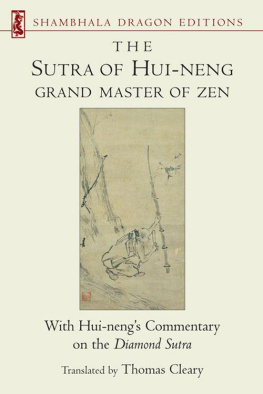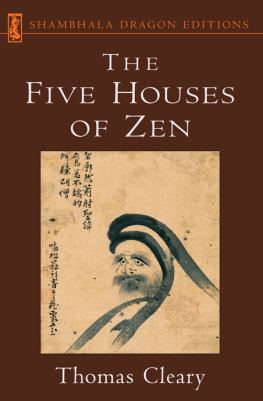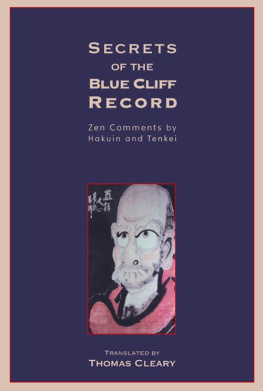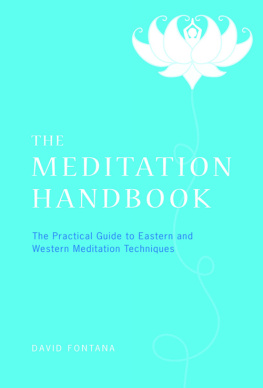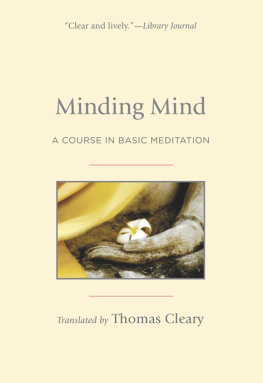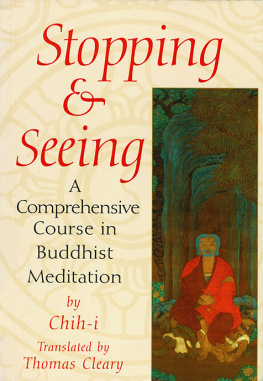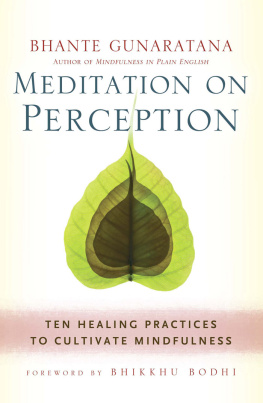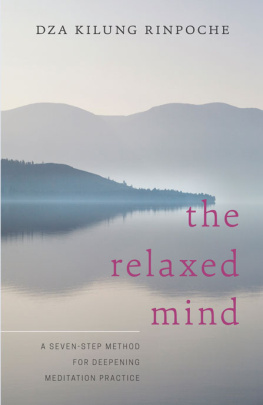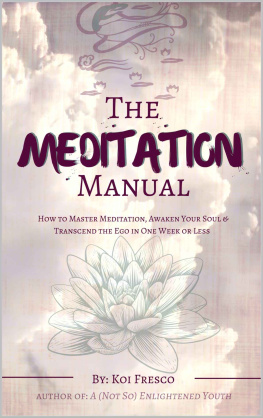Body, Mind, and Breath:
A meditation handbook
By Thomas Cleary
Foreword
Meditation has long been practiced in many cultures, and many modes, for a variety of purposes. In the context of Buddhism, many kinds of meditation are described for what are considered both ordinary and spiritual aims. Meditation has been applied to healing illness, mitigating pain, improving health, and changing habits, as well as developing character, capability, and composure.
The range of methods used in Buddhist meditation is very broad. The underlying reason for this is the immense capacity for experience in the human brain; the immediate reason is the diverse spectrum of individual needs and mentalities for which specific means have been designed over the ages.
The traditional metaphor for all Buddhist teachings and practices, including all forms of meditation, is medicinal prescription. The differences in methods and techniques are likened to differences in prescriptions for different illnesses, in people of different constitutions. This analogy also includes a corresponding warning about the dangers of misuse or inappropriate application of meditation methods.
This instruction book presents translations of two famous manuals of meditation, called Six Methods of Sublimation and Elementary Stopping and Seeing. These are noted for the particular advantage of easy access, even for beginners, along with a systematic approach to individual experimental discovery of the method or methods that work best for you.
The author of these manuals, Zhiyi, was a distinguished Buddhist monk of the sixth century, a specialist in meditation, ranked as a great master in the histories of three major schools of Buddhism: Tiantai, Chan, and Pure Land. While a professed Buddhist, his work also reflects a background in esoteric Taoist culture. His mother was a member of a clan associated with the highest echelons of the Maoshan sect of esoteric Taoism, and the sacred Mount Tiantai in China where he taught for a time was also a Taoist center.
The first manual presented here, Six Methods of Sublimation, begins with a well known method of meditation on the breathing, using it as an entry way into progressively more subtle and sophisticated exercises, leading to inner peace. The other manual, Elementary Stopping and Seeing, particularly applicable to retreat, teaches essential contemplative techniques, and also treats a range of mind-body management issues associated with meditation.
Six Methods of Sublimation
Introduction
The six methods of sublimation are the bases of inner practice, the essential path to attain the enlightenment of the three vehicles. Therefore, when akyamuni first went to the tree under which he attained enlightenment, he sat cross legged on a pile of grass and meditated inwardly on breathing, first counting, second following, third stopping, fourth seeing, fifth returning, and sixth purifying. From these, myriad practices developed, and he overcame demons and attained enlightenment.
Obviously, since Buddha was an example for people as he demonstrated this course, how could sane people in the three vehicles not travel the same road?
Six is a way of enumerating, using a number to elucidate meditation. That is why it says six in the way that the Buddha sometimes used the number one to discuss mediation, referring to absorption in one practice; and sometimes used the number two, referring to stopping and seeing. Sometimes he used the number three, referring to three absorptions; sometimes used the number four, referring to four meditations. Sometimes he used the number five, referring to five-method meditation; sometimes he used the number six, referring to the six methods of sublimation. Sometimes he used the number seven, referring to seven basis concentration; sometimes he used the number eight, referring to the eight detachments. Sometimes he used the number nine, referring to nine successive concentrations; sometimes he used the number ten, referring to ten branches of meditation.
Hundreds, thousands, myriads, incalculable, inexpressible numbers of methods of absorption are all explanations of meditation by the numbers. Although they are numerically more or less, when you thoroughly examine their technical characteristics you find they all contain each other. It is because peoples faculties and understandings are not the same that there are numerically more or less distinguished to help people.
Now six titles this work in terms of a way of enumerating. Sublimation has many meanings, but the main meaning is nirvana, the truth of extinction of misery. Therefore the content of the four practices of extinction are referred to as extinction, cessation, sublimation, and detachment.
Nirvana is not annihilation, and not eternity either. While existent, it is hard to accord; while nonexistent, it is easy to attain. Hence it is called subtle.
Six methods can provide access, so they are called doors. Although there are six doors, when you attain sublimation they are not different. Therefore scripture says, Nirvana is the real treasure of the teaching; people enter through various doors.
This is a comprehensive interpretation of the overall meaning of the six methods of sublimation. The overall meaning of the six methods of sublimation is ten-fold:
1) The six methods of sublimation in particular reference to the various meditations;
2) The six methods of sublimation in succession
3) The six methods of sublimation according to efficiency
4) The six methods of sublimation as specific remedies
5) The six methods of sublimation containing one another
6) Common and particular six methods of sublimation
7) Continuous six methods of sublimation
8) Six doors of sublimation observing mind
9) Six doors of sublimation with complete observation
10) Six doors of sublimation in terms of realizations
Six Methods of Sublimation in Succession
Counting
There are two kinds of counting: cultivating counting, then realizing counting.
In cultivating counting, adjust the breathing so that it is neither halting nor hasty. Calmly, attentively, slowly count breaths from one to ten, keeping the mind on counting, not letting it run off distracted. This is called cultivating counting.
In realizing counting, awareness spontaneously goes from one to ten, without applying any effort. The mind stays focused on the breathing. Sensing the breath immaterial and subtle, the state of mind gradually becomes refined, until counting comes to feel crude, and the mind is no longer inclined to count. At this point, let go of counting and cultivate following.
Following
Following is also twofold, cultivating following and realizing following.
To cultivate following, give up the preceding method of counting and single-mindedly follow outgoing and incoming breath, concentrating the mind on the breathing, keeping aware of the incoming and outgoing of the breath, so the mind stays focused on the breathing, without any distraction. This is called cultivating following.
In realizing following, the mind is now refined, calm, and undisturbed, aware of the length of each breath, feeling the breath coming in and going out through the entire body. Mind and breath spontaneously stay together, thought peacefully stills into quietude. Sensing following as crude, the mind wearies of it and wishes to give it up, like someone who is fatigued in the extreme wants to sleep and does not relish chores. Then you should give up following and cultivate stopping.
Stopping
Stopping is also twofold: cultivating stopping and realizing stopping.
Cultivating stopping means ceasing thoughts of objects, not being mindful of counting or following, but stilling and silencing the mind. This is called cultivating stopping.
Next page

